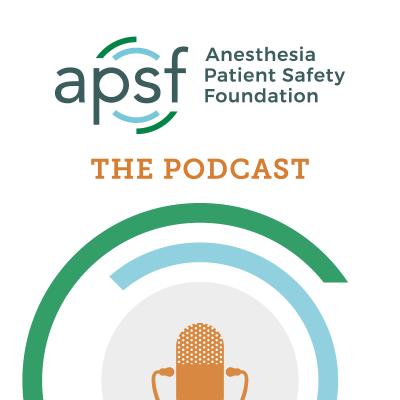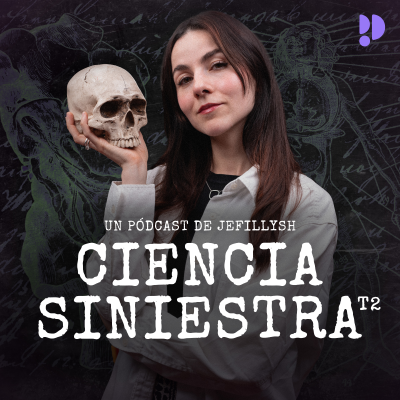
Anesthesia Patient Safety Podcast
inglés
Tecnología y ciencia
Empieza 7 días de prueba
$99 / mes después de la prueba.Cancela cuando quieras.
- 20 horas de audiolibros al mes
- Podcasts solo en Podimo
- Podcast gratuitos
Acerca de Anesthesia Patient Safety Podcast
The official podcast of the Anesthesia Patient Safety Foundation (APSF) is hosted by Alli Bechtel, MD, featuring the latest information and news in perioperative and anesthesia patient safety. The APSF podcast is intended for anesthesiologists, anesthetists, clinicians and other professionals with an interest in anesthesiology, and patient safety advocates around the world.The Anesthesia Patient Safety Podcast delivers the best of the APSF Newsletter and website directly to you, so you can listen on the go! This includes some of the most important COVID-19 information on airway management, ventilators, personal protective equipment (PPE), drug information, and elective surgery recommendations.Don't forget to check out APSF.org for the show notes that accompany each episode, and email us at podcast@APSF.org with your suggestions for future episodes. Visit us at APSF.org/podcast and at @APSForg on Twitter, Facebook, and Instagram.
Todos los episodios
285 episodios#285 Safer Smiles
A routine dental visit should never turn into a medical emergency. We sit down with Dr. Rita Agarwal, pediatric anesthesiologist and patient safety advocate, to unpack why dental anesthesia operates on a separate track from hospital-based care—and how that gap can put patients at risk. From the heartbreaking story of six-year-old Caleb Sears to the hard truths about monitoring requirements, staffing models, and training, this conversation brings clarity to a topic most families and many clinicians assume is standardized. We dive into what “sedation” really means in dentistry, why route-based labels can hide true depth of anesthesia, and how inconsistent state rules leave dangerous blind spots. Dr. Agarwal explains the pillars of safer dental sedation: careful patient selection, a separate and qualified anesthesia provider for deep sedation or general anesthesia, and the ability to rescue from the next deeper level, including effective bag-mask ventilation and the timely use of reversal agents. We also explore the role of capnography, reliable oxygen supply, and scenario-based drills that make rapid response second nature. Safety grows when systems learn. That’s why we spotlight the urgent need for robust data: routine reporting of outcomes and near misses from dental offices using a simple, standardized tool. Pair that with harmonized terminology aligned to ASA levels, simulation training, and clear emergency protocols, and dentistry can match the reliability gains anesthesia has achieved in hospitals. For parents and patients, we offer direct, practical questions to ask before consenting to sedation—who monitors, what training they have, what equipment is on hand, and whether sedation is truly necessary. If this conversation gave you new tools or changed your perspective, help us spread the word. Subscribe, share with a colleague or a parent who needs it, and leave a review so more people can find evidence-based guidance on dental anesthesia safety. For show notes & transcript, visit our episode page at apsf.org: https://www.apsf.org/podcast/285-safer-smiles/ [https://www.apsf.org/podcast/285-safer-smiles/] © 2025, The Anesthesia Patient Safety Foundation
#284 Safer C-Section Pain Control with Ruth Landau, MD
The fastest way to improve post-cesarean recovery is to start before the first incision—by setting expectations, testing the block, and validating what patients feel. We sit down with Dr. Ruth Landau, Virginia Apgar Professor and Chief of Obstetric Anesthesia at Columbia University, to map a safer path from the OR to the nursery: neuraxial-first analgesia, scheduled non-opioids, and small, truly PRN opioid prescriptions at discharge. She explains how intrapartum cesareans carry higher risk for discomfort and why simple shifts—active epidural management, timely redosing, and clear, compassionate communication—reduce pain, opioid exposure, and the chance of a traumatic birth experience. We break down practical steps that clinicians can apply today. Learn the difference between systemic and neuraxial opioids for breastfeeding safety, when to use ultrasound-guided TAP or QL blocks after general anesthesia, and how micro-boluses of IV dexmedetomidine can blunt visceral sensations, anxiety, and shivering. Dr. Landau also shares the latest from ASA statements and SOAP guidance, including dose-dependent monitoring strategies that make neuraxial opioids feasible even in resource-constrained settings. The conversation moves beyond pharmacology to focus on outcomes that matter to families: fewer leftovers at home, less persistent opioid use, and birth memories grounded in trust instead of fear. We talk debriefs, trauma-informed care, and patient-reported experience measures, plus new research on sensation profiles and intrathecal adjuvants like dexmedetomidine and clonidine. If you’re building an opioid-sparing cesarean pathway—or refining the one you have—this is a clear, evidence-informed playbook. If this resonates with you, follow the show, share it with your OB and nursing teams, and leave a review with one change you plan to make next shift. Your feedback helps more clinicians find these strategies and keeps more parents safe and comfortable. For show notes & transcript, visit our episode page at apsf.org: https://www.apsf.org/podcast/284-safer-c-section-pain-control-with-ruth-landau-md/ [https://www.apsf.org/podcast/284-safer-c-section-pain-control-with-ruth-landau-md/] © 2025, The Anesthesia Patient Safety Foundation
#283 How To Plan, Induce, And Recover Patients With Anterior Mediastinal Masses Without Triggering Collapse
Anterior mediastinal masses make even seasoned anesthesiologists pause, and for good reason: a stable, upright patient can decompensate with a single change in position or a single dose of the wrong drug. We walk through a clear, stepwise approach that starts with anatomy and symptom red flags, then translates imaging, echocardiography, and pulmonary function testing into real-world decisions at the bedside. The focus stays practical: how to pick the safest setting, when to avoid general anesthesia, and what to prepare before anyone touches the airway. We break down adult and pediatric risk criteria, including mass-to-chest ratio, degree of tracheal compression, SVC obstruction, pericardial effusion, and standardized tumor volume in children. From there, we outline sedation-first strategies using ketamine, dexmedetomidine, and carefully titrated remifentanil to preserve spontaneous ventilation and avoid precipitous loss of tone. For patients who truly need general anesthesia, we share an OR playbook: lower-extremity access when SVC flow is threatened, semi-upright preoxygenation, slow induction while maintaining spontaneous ventilation, awake intubation options, and selective use of short-acting agents to test tolerance of positive pressure. Ventilation choices can make or break the case. We explain why long expiratory times and low respiratory rates reduce air trapping and auto-PEEP, and how fiberoptic bronchoscopy can guide tube position, predict extubation risk, and inform postoperative support. Rescue pathways are explicit: repositioning and CPAP, mechanical stenting with an endotracheal tube or rigid bronchoscope, rapid escalation to airway stents, and ECMO when distal collapse or cardiovascular compromise persists. We also spell out who needs ICU monitoring after surgery and why the safest path often means doing less. If this topic raises your heart rate, you’re not alone. Tune in to sharpen your plan, align your team, and build a safer pathway from preop to postop for both adults and kids. Subscribe, share with your OR team, and leave a review with your best tip for managing high-risk mediastinal masses. For show notes & transcript, visit our episode page at apsf.org: https://www.apsf.org/podcast/283-how-to-plan-induce-and-recover-patients-with-anterior-mediastinal-mass-without-triggering-collapse/ [https://www.apsf.org/podcast/283-how-to-plan-induce-and-recover-patients-with-anterior-mediastinal-mass-without-triggering-collapse/] © 2025, The Anesthesia Patient Safety Foundation
#282 Building Safer Anesthesia Teams In A Locum-Driven World
Ever walked into a new OR and spent the first ten minutes hunting for an airway bougie or a computer log-in that actually works? We dig into the hidden safety risks of a transient anesthesia workforce and share practical, fast-moving fixes that keep patients safe while keeping rooms open. With staffing shortages reshaping coverage models across the United States and beyond, locum clinicians are essential—but inconsistent environments, unclear escalation paths, and fragmented communication can turn small friction points into big hazards. We unpack what the current evidence says—and doesn’t—about locum-related outcomes. A UK qualitative study surfaces predictable threats like unfamiliar systems and weak team integration, while primary care data shows prescribing differences without higher adverse events. In anesthesia, large safety studies are scarce, so leaders must rely on smart design: targeted orientation, standardized room setups, and shared mental models that don’t depend on who’s on the schedule. We also talk dollars and sense, highlighting a simulation-based break-even estimate for when full-time hiring outperforms locum coverage, and how to weigh cost without compromising safety. From the main OR to higher-risk non-operating room anesthesia sites, we outline concrete steps that work across settings. Limit initial deployment to oriented locations, add locum staff to all communication channels from day one, and use checklists, cognitive aids, and universal timeouts to reduce variability. Establish clear role definitions and escalation trees posted in every anesthetizing location, and fold temporary clinicians into audits, feedback loops, and ongoing education. The aim is simple: compress the ramp-up, eliminate guesswork, and make the safe action the easy action—even when teams change daily. If you care about perioperative safety, access, and team resilience, this conversation gives you a playbook to act now. Subscribe, share with a colleague who onboards locums, and email your best orientation tip so we can feature it on a future show. For show notes & transcript, visit our episode page at apsf.org: https://www.apsf.org/podcast/282-building-safer-anesthesia-teams-in-a-locum-driven-world/ [https://www.apsf.org/podcast/282-building-safer-anesthesia-teams-in-a-locum-driven-world/] © 2025, The Anesthesia Patient Safety Foundation
#281 Safer Anesthesia, Everywhere
Imagine stepping into an operating room where oxygen isn’t guaranteed, capnography is rare, and one anesthesiologist might serve a million people. That’s the reality many patients face, and it’s exactly where meaningful change can save the most lives. We sit down with Dr. Kelly McQueen, professor of anesthesiology and department chair at the University of Wisconsin, to explore what it takes to deliver safe anesthesia in low and middle-income countries and how practical solutions—rooted in training, equipment reliability, and data—can close the gap. We trace how safety became foundational in anesthesiology in high-resource settings while many colleagues abroad still rely on vigilant listening and teamwork to compensate for missing monitors and essential medicines. Dr. McQueen explains the workforce crisis—too few trained providers, concerns with credentialing, limited continuing education—and why the fix starts with lifting current teams, not replacing them. We discuss how ministries of health, medical schools, and national anesthesia societies can drive lasting change by investing in local training pipelines, fair compensation, and clear standards that elevate both physician and non-physician providers. From the WHO Surgical Safety Checklist to Lifebox-style initiatives, we look at how checklists adapted to local constraints can improve outcomes when paired with reliable oxygen, pulse oximetry, and capnography. We also dive into the power of perioperative mortality reviews which can turn scarce data into quality improvement that sticks. Dr. McQueen makes a compelling case for bilateral partnerships that build capability, confidence, and leadership so anesthesiologists can advocate for what their patients need most. If you care about global health equity, safer surgery, and the systems that truly protect patients, this conversation brings clarity and momentum. Listen, share with a colleague, and subscribe so you don’t miss future episodes—and leave a review to help others find the show. For show notes & transcript, visit our episode page at apsf.org: https://www.apsf.org/podcast/281-safer-anesthesia-everywhere/ [https://www.apsf.org/podcast/281-safer-anesthesia-everywhere/] © 2025, The Anesthesia Patient Safety Foundation
Elige tu suscripción
Premium
20 horas de audiolibros
Podcasts solo en Podimo
Podcast gratuitos
Cancela cuando quieras
Empieza 7 días de prueba
Después $99 / month
Empieza 7 días de prueba. $99 / mes después de la prueba. Cancela cuando quieras.























